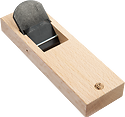Niwaki Plane
Kanna
A great introduction to the world of Japanese carpenter’s planes, with a hard wearing and easy to sharpen laminated SK steel blade, set within a Japanese White Oak block (dai).
As with most Japanese tools, the cutting (or in this case, planing) is achieved with a pull stroke (ie pulling towards you) not pushing away, which soon becomes natural and offers more control, we think.
Setting up Kanna (Japanese planes) is a bit of a knack - have a look here for detailed information youtu.be/QQytHrqMsug (Sumokun’s YouTube channel is not affiliated to, or sponsored by, Niwaki in anyway - he’s just keen to help!)
Delivering to US (Paying in USD)


